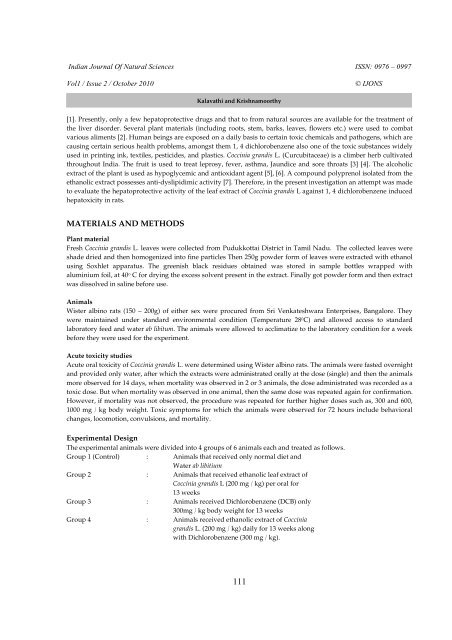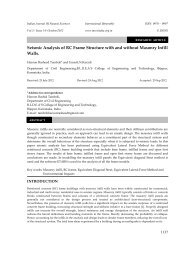Agroecology for Sustainable Food Security - tnsroindia.org.in
Agroecology for Sustainable Food Security - tnsroindia.org.in
Agroecology for Sustainable Food Security - tnsroindia.org.in
Create successful ePaper yourself
Turn your PDF publications into a flip-book with our unique Google optimized e-Paper software.
Indian Journal Of Natural Sciences ISSN: 0976 – 0997<br />
Vol1 / Issue 2 / October 2010 © IJONS<br />
[1]. Presently, only a few hepatoprotective drugs and that to from natural sources are available <strong>for</strong> the treatment of<br />
the liver disorder. Several plant materials (<strong>in</strong>clud<strong>in</strong>g roots, stem, barks, leaves, flowers etc.) were used to combat<br />
various aliments [2]. Human be<strong>in</strong>gs are exposed on a daily basis to certa<strong>in</strong> toxic chemicals and pathogens, which are<br />
caus<strong>in</strong>g certa<strong>in</strong> serious health problems, amongst them 1, 4 dichlorobenzene also one of the toxic substances widely<br />
used <strong>in</strong> pr<strong>in</strong>t<strong>in</strong>g <strong>in</strong>k, textiles, pesticides, and plastics. Cocc<strong>in</strong>ia grandis L. (Curcubitaceae) is a climber herb cultivated<br />
throughout India. The fruit is used to treat leprosy, fever, asthma, Jaundice and sore throats [3] [4]. The alcoholic<br />
extract of the plant is used as hypoglycemic and antioxidant agent [5], [6]. A compound polyprenol isolated from the<br />
ethanolic extract possesses anti-dyslipidimic activity [7]. There<strong>for</strong>e, <strong>in</strong> the present <strong>in</strong>vestigation an attempt was made<br />
to evaluate the hepatoprotective activity of the leaf extract of Cocc<strong>in</strong>ia grandis L aga<strong>in</strong>st 1, 4 dichlorobenzene <strong>in</strong>duced<br />
hepatoxicity <strong>in</strong> rats.<br />
MATERIALS AND METHODS<br />
Kalavathi and Krishnamoorthy<br />
Plant material<br />
Fresh Cocc<strong>in</strong>ia grandis L. leaves were collected from Pudukkottai District <strong>in</strong> Tamil Nadu. The collected leaves were<br />
shade dried and then homogenized <strong>in</strong>to f<strong>in</strong>e particles Then 250g powder <strong>for</strong>m of leaves were extracted with ethanol<br />
us<strong>in</strong>g Soxhlet apparatus. The greenish black residues obta<strong>in</strong>ed was stored <strong>in</strong> sample bottles wrapped with<br />
alum<strong>in</strong>ium foil, at 40 o C <strong>for</strong> dry<strong>in</strong>g the excess solvent present <strong>in</strong> the extract. F<strong>in</strong>ally got powder <strong>for</strong>m and then extract<br />
was dissolved <strong>in</strong> sal<strong>in</strong>e be<strong>for</strong>e use.<br />
Animals<br />
Wister alb<strong>in</strong>o rats (150 – 200g) of either sex were procured from Sri Venkateshwara Enterprises, Bangalore. They<br />
were ma<strong>in</strong>ta<strong>in</strong>ed under standard environmental condition (Temperature 28 0 C) and allowed access to standard<br />
laboratory feed and water ab libitum. The animals were allowed to acclimatize to the laboratory condition <strong>for</strong> a week<br />
be<strong>for</strong>e they were used <strong>for</strong> the experiment.<br />
Acute toxicity studies<br />
Acute oral toxicity of Cocc<strong>in</strong>ia grandis L. were determ<strong>in</strong>ed us<strong>in</strong>g Wister alb<strong>in</strong>o rats. The animals were fasted overnight<br />
and provided only water, after which the extracts were adm<strong>in</strong>istrated orally at the dose (s<strong>in</strong>gle) and then the animals<br />
more observed <strong>for</strong> 14 days, when mortality was observed <strong>in</strong> 2 or 3 animals, the dose adm<strong>in</strong>istrated was recorded as a<br />
toxic dose. But when mortality was observed <strong>in</strong> one animal, then the same dose was repeated aga<strong>in</strong> <strong>for</strong> confirmation.<br />
However, if mortality was not observed, the procedure was repeated <strong>for</strong> further higher doses such as, 300 and 600,<br />
1000 mg / kg body weight. Toxic symptoms <strong>for</strong> which the animals were observed <strong>for</strong> 72 hours <strong>in</strong>clude behavioral<br />
changes, locomotion, convulsions, and mortality.<br />
Experimental Design<br />
The experimental animals were divided <strong>in</strong>to 4 groups of 6 animals each and treated as follows.<br />
Group 1 (Control) : Animals that received only normal diet and<br />
Water ab libitium<br />
Group 2 : Animals that received ethanolic leaf extract of<br />
Cocc<strong>in</strong>ia grandis L (200 mg / kg) per oral <strong>for</strong><br />
13 weeks<br />
Group 3 : Animals received Dichlorobenzene (DCB) only<br />
300mg / kg body weight <strong>for</strong> 13 weeks<br />
Group 4 : Animals received ethanolic extract of Cocc<strong>in</strong>ia<br />
grandis L. (200 mg / kg) daily <strong>for</strong> 13 weeks along<br />
with Dichlorobenzene (300 mg / kg).<br />
111



